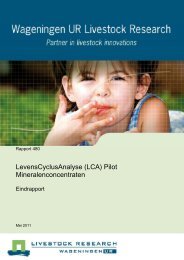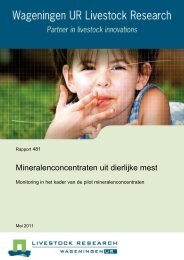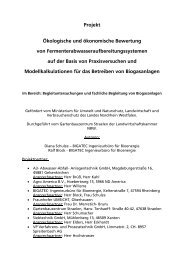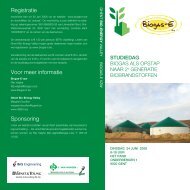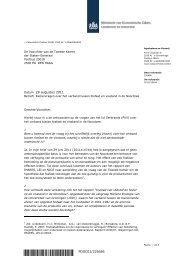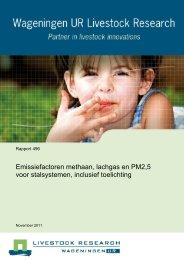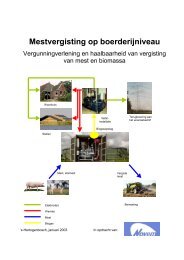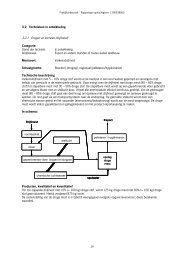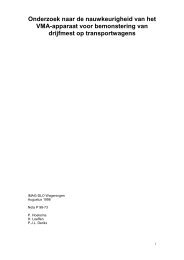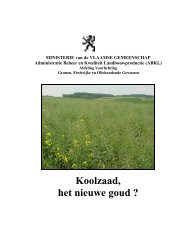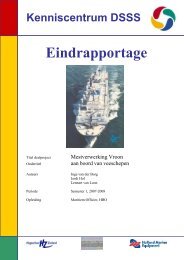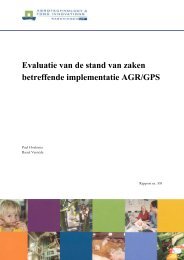Monitoring methane and nitrous oxide reduction by manure treatment
Monitoring methane and nitrous oxide reduction by manure treatment
Monitoring methane and nitrous oxide reduction by manure treatment
Create successful ePaper yourself
Turn your PDF publications into a flip-book with our unique Google optimized e-Paper software.
Report 627<br />
The amount of 842 kton is approx. 70% of the total amount of <strong>manure</strong> digested, which means that in<br />
2010 approx. 1.2 Mton of <strong>manure</strong> was digested in the Netherl<strong>and</strong>s. Manure accounted for 52% to the<br />
total digester input of 2.3 Mton, which results in an output of 2.1 Mton.<br />
This one time evaluation provides reliable (based on 74% respons of inquiry) quantitative information<br />
on the amounts of livestock <strong>manure</strong> co-digested in the Netherl<strong>and</strong>s in 2010.<br />
3) Practical initiatives of <strong>manure</strong> <strong>treatment</strong> (Timmerman & De Buisonjé, 2010).<br />
This inventory provides an overview of <strong>manure</strong> <strong>treatment</strong> operations in the Netherl<strong>and</strong>s in 2009. Codigestion<br />
was excluded from the inventory; operations that used digestate as raw material were<br />
included. The reported information was mainly based on an inquiry among the <strong>manure</strong> <strong>treatment</strong><br />
operations that are recognized <strong>by</strong> the Netherl<strong>and</strong>s Food <strong>and</strong> Consumer Product Safety Authority<br />
(NVMA). The <strong>treatment</strong> technology, capacity, input material, end products <strong>and</strong> destination of the end<br />
products were registered. This information could not be collected from all operations, so only minimal<br />
figures could be reported. Table 2 shows the main <strong>treatment</strong> technics, related to greenhouse gas<br />
emission, <strong>and</strong> the minimal amounts of <strong>manure</strong> treated.<br />
Table 2 Main <strong>manure</strong> <strong>treatment</strong> technologies (co-digestion excluded) <strong>and</strong> the minimal amounts of<br />
<strong>manure</strong> treated in the Netherl<strong>and</strong>s in 2009 (Timmerman & De Buisonjé, 2010).<br />
Treatment<br />
Minimal amount of<br />
<strong>manure</strong> treated<br />
(ton)<br />
Main type of <strong>manure</strong><br />
Nitrification/denitrification 795,000 Veal calf <strong>manure</strong><br />
Incineration 353,000 Poultry <strong>manure</strong><br />
Composting/drying/pelleting 302,000 Poultry <strong>and</strong> horse <strong>manure</strong> <strong>and</strong> solid fraction<br />
Production of mineral concentrates 253,000 Pig slurry<br />
Solid/liquid separation 152,000 Digestate from cow <strong>manure</strong> co-digestion<br />
Table 2 gives a valuable overview of the key <strong>manure</strong> <strong>treatment</strong> techniques used in the Netherl<strong>and</strong>s in<br />
2009 <strong>and</strong> their respective relevance. The information concerning amounts of <strong>manure</strong> treated, amounts<br />
of the end products <strong>and</strong> their destination is qualified as moderate reliable because the information is<br />
incomplete. None of the listed <strong>treatment</strong>s are taken into account in determining national emissions of<br />
<strong>methane</strong> <strong>and</strong> <strong>nitrous</strong> <strong>oxide</strong> in the Netherl<strong>and</strong>s today.<br />
4) Monitor <strong>manure</strong> market 2010 (Luesink et al., 2011)<br />
This monitor pictures the <strong>manure</strong> market in the Netherl<strong>and</strong>s on an annual basis. The work is carried<br />
out according a monitoring protocol which was developed in 2009 (van den Born et al., 2009). The<br />
monitor provides broad information on the amount of <strong>manure</strong> that is treated <strong>and</strong> the end products from<br />
<strong>manure</strong> <strong>treatment</strong> as well as the destination of the end products. This information is based on <strong>manure</strong><br />
transport data as registered <strong>by</strong> Dienst Regelingen (DR) <strong>and</strong> on results of additional questioning in the<br />
L<strong>and</strong>bouwtelling <strong>by</strong> CBS. The reliability of this data source is questionable (see also source 5).<br />
5) Manure transport data from Dienst Regelingen (DR)<br />
DR is the government department for registration of <strong>manure</strong> transport data within the framework of the<br />
Dutch <strong>manure</strong> regulations. The protocols for the registration of the amount <strong>and</strong> the N- <strong>and</strong> P-content<br />
of <strong>manure</strong> transported from one party (provider) to another party (intermediate, user) are described in<br />
the Uitvoeringsregeling meststoffenwet (Staatscourant 21 november 2005). Data of an individual<br />
transport is registered in a <strong>manure</strong> transport document (VDM) which is transferred to DR. Within this<br />
registration system the transported <strong>manure</strong> is classified <strong>by</strong> <strong>manure</strong> code. Each animal species has its<br />
<strong>manure</strong> code. The system takes account of <strong>manure</strong> management <strong>and</strong> distinguishes between solid <strong>and</strong><br />
liquid fractions of cow <strong>and</strong> pig <strong>manure</strong> after separation. There is a <strong>manure</strong> code for compost,<br />
champost <strong>and</strong><br />
8





